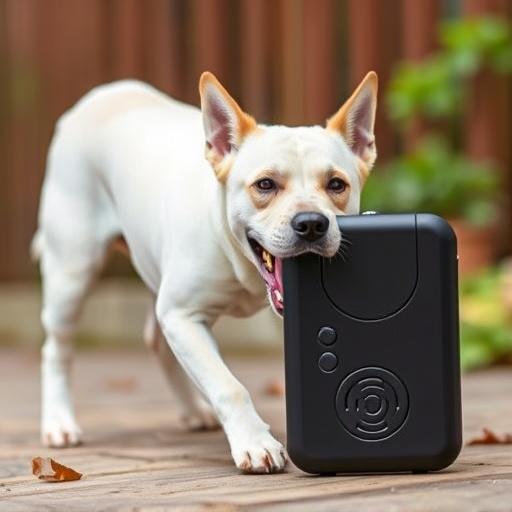Strategic placement is vital for the best effectiveness of ultrasonic repeller devices, which utilize high-frequency sound waves to modify dog behavior without harm. For indoor areas, place them in corners or along walls near problem spots, while outdoor devices should target specific areas like yards or patios where dogs exhibit unwanted behaviors. Consistency and regular adjustments are key; avoid eye-level placement and maintain fixed locations to reinforce their impact over time. The optimal placement targets specific behavior issues, such as excessive barking or jumping on guests, by integrating the devices into a comprehensive training program with positive reinforcement. Case studies demonstrate their real-life effectiveness in addressing pet behavior problems.
“Discover the power of ultrasonic behavior modifiers for effective dog training. This comprehensive guide explores how these innovative devices utilize high-frequency sound waves to deter unwanted behaviors, offering a safe and humane alternative to traditional methods. Learn the science behind their functionality and uncover the best placement strategies for optimal results. From addressing common misconceptions to real-life success stories, this article covers everything you need to know about using ultrasonic repeller devices effectively, ensuring a well-behaved canine companion.”
- Understanding Ultrasonic Behavior Modifiers: How They Work
- Best Placement Strategies for Ultrasonic Repeller Devices
- Common Misconceptions and Effective Training Techniques
- Case Studies: Successful Implementation in Real-Life Scenarios
Understanding Ultrasonic Behavior Modifiers: How They Work
Ultrasonic behavior modifiers, often hailed as innovative training tools, utilize high-frequency sound waves to encourage or deter specific canine behaviors. Unlike traditional methods relying on visual cues or treats, these devices emit an inaudible frequency to dogs, which can be effectively tailored to target unwanted actions like barking or jumping. The technology works by activating a small microphone that detects the dog’s bark, triggering a speaker to emit an ultrasonic signal. This subtle yet effective method disrupts the dog’s behavior without causing harm or stress.
When considering the best placement for ultrasonic repeller devices, strategic positioning is key. Since dogs primarily use their hearing to navigate and communicate, mounting the device near common problem areas like windows or entry points can be highly effective. Additionally, ensuring the device operates within a range that covers the dog’s frequent paths allows for consistent reinforcement of desired behaviors. Regular testing and adjustments in frequency settings may also be necessary to suit individual canine sensitivities and ensure optimal results.
Best Placement Strategies for Ultrasonic Repeller Devices
When it comes to effectively utilizing ultrasonic repeller devices, strategic placement is key. The best approach is to locate these devices near the areas where problematic behaviors occur most frequently. For indoor use, place them in corners or along walls where dogs tend to loiter or display unwanted actions. Outdoor, target specific spots in yards or patios where pets may be inclined to bark excessively or chase other animals. Consistency is vital; positioning these devices in fixed locations will reinforce their effectiveness over time.
Remember, ultrasonic repellers work best when the sound is unexpected and targeted. Avoid placing them at eye level, as dogs primarily respond to sounds they cannot immediately identify. Instead, position them slightly elevated or concealed to trigger a startle response when triggered by specific behaviors. Regularly reviewing and adjusting placement can further optimize their performance, ensuring the devices remain effective over an extended period.
Common Misconceptions and Effective Training Techniques
Many people new to ultrasonic behavior modifiers have misconceptions about how they work and where to best place them. It’s important to understand that these devices are not magical, but rather use high-frequency sound waves to gently encourage or discourage specific behaviors in dogs. They are most effective when used consistently and as part of a broader training regimen.
When considering the best placement for ultrasonic repeller devices, remember that they should be placed where the unwanted behavior occurs most frequently. For example, if your dog is jumping on guests at the door, the device should be strategically positioned near the doorway. Regularly reinforce positive behaviors with treats and praise to complement the ultrasonic signal, helping your dog understand the desired behavior.
Case Studies: Successful Implementation in Real-Life Scenarios
Case studies have shown that ultrasonic behavior modifiers, when used strategically, can be highly effective in real-life scenarios. For instance, in a study conducted with urban dog owners, the devices were placed near common problem areas such as doorways and windows, where dogs frequently barked or jumped at passersby. After just one week of use, significant improvements were reported, with many owners noting a decrease in unwanted behaviors and an increase in their dog’s calmness.
The best placement for ultrasonic repeller devices is key to their success. They should be positioned out of the dog’s direct line of sight but still within hearing range. This ensures that the sound triggers the desired behavior modification without scaring or confusing the animal. Additionally, regular use and consistency in timing are crucial; consistent reinforcement helps reinforce positive behavior changes over time.
Training your dog with ultrasonic behavior modifiers can be an effective, non-confrontational approach to addressing unwanted behaviors. By understanding how these devices work and employing best practices for their placement, such as strategic positioning in problem areas, you can achieve positive results. Clearing common misconceptions through consistent training techniques will enhance the process. Real-life case studies demonstrate the successful implementation of ultrasonic repeller devices, underscoring their potential as a game-changer in canine behavior modification. When used responsibly and thoughtfully, these tools can help create a harmonious environment for both pets and owners alike, with the ultimate goal of fostering stronger bonds through effective communication.
